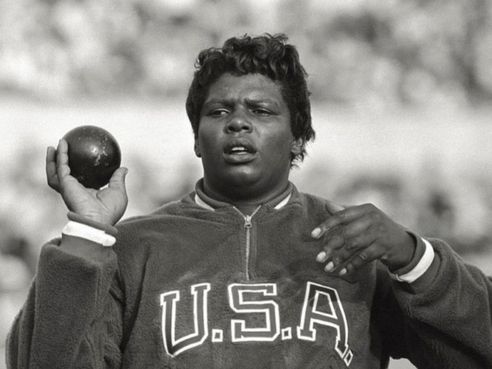Black History Month Spotlight: Earlene Brown
02/15/2023
Earlene Brown is a three-time Olympian and the first U.S. woman to medal in the shot put
Article has been edited from its original version on Encyclopedia.com
Born in Latexo, Texas, on July 11, 1935, Earlene Brown made magic when she tried her hand at shot put. In 1960, the AAU alumna became the first U.S. woman to ever win an Olympic medal in shot put and, in the years before and after her historic win, she took home numerous medals and records at AAU championships.
Early Life and Competing with AAU
Brown's high-school gym teacher, Addie Valdez, was the first to put the discus in Brown’s talented hands, and in the schoolyard, Brown's history teacher taught her to shot put.
All of Brown’s hard work came together in August of 1956 when she competed in the AAU Outdoor Nationals held in Philadelphia. There, she set a new American record with a throw of 45′, while also taking second for the discus.
It seemed unlikely, however, that Brown would be able to defend her American record at the Olympic trials held a week later in Washington, D.C., because she did not have the money to attend. The Sentinel, Los Angeles' Black newspaper, took up a collection and sent her; this gesture not only supported Brown as an individual athlete but also opened the door for the sports' history she was to shape.
Sportswriters across America began to write about Brown, as she overtook Lois Testa in shot put and Pam Kurrell in discus to become a double winner and the leading member of the Olympic team. Less than four months after she joined the AAU, Brown held the American records for shot put and discus.
At the 1956 Olympic Games in Melbourne, Australia, Brown would not medal, placing sixth, but she did improve her American record.
Following the Olympics, Brown spent the next two years competing in AAU and national track and field competitions. In 1957, at the AAU Outdoor Nationals held in Cleveland, Ohio, she placed second in both the discus and the shot put, a record she was to improve in 1958 at the Outdoor Nationals in Monmouth, New Jersey.
The winners of this meet were scheduled to participate in a series of international track and field events in Europe, and the prospect of overseas travel was a great motivator for Brown. She competed fiercely and won a gold medal, breaking her old American record in shot put with a throw of 47′5½″. She also won a gold medal in discus with a toss that sailed 152′5½".
The European meets proved a showcase for Brown. In the shot put, Brown threw further than any American athlete ever and took the gold medal with a toss of 54′3½". Her performance in the discus was almost as impressive when she took second with a throw of over 162′. At the Warsaw meet, she won the gold medal in both shot put and discus.
"Mrs. Earlene Brown is the toast of Moscow," gushed the Associated Press, "just as she was the most widely known of the United States athletes in the Olympic Village in Melbourne in 1956."
The European meets ended in Athens, Greece, where Brown gave a stunning performance. In the discus event, she threw an amazing 153′8¾". Not only did she win the gold medal, but the discus flew out of the stadium and into the crowd, soundly smacking two spectators. When Earlene learned she had hit someone, she went over with an interpreter to apologize. Replied one of the spectators: "That's all right; it doesn't hurt much -- but could I have your autograph?" Brown hugged the woman to the delight of the crowd.
She returned home with seven gold medals and one silver. Many compared her to Babe Didrikson Zaharias and said she had the potential to become one of the greatest women athletes ever.
In 1959, Brown continued her dominance. She won first place in the AAU Outdoor Nationals and set meet records when she participated in the Pan-American Games later that year. She then placed second in the dual USSR-USA meet, her throw three feet shy of the previous year's.
Making History
During the 1960 Olympics in Rome, Brown cemented her role in sports history. Her throw of 53′10⅜" earned her the bronze medal and the title of first American woman to ever win an Olympic medal in shot put. Two weeks later, she went on to compete in track and field meets in Frankfurt, West Germany, and Greece.
After returning home in 1961, Brown entered the AAU Indoor competition and was again chosen to represent the U.S. in a series of European meets. But financial constraints kept her home. Having just purchased a beauty shop for $10,000 with a $1,000 down payment, she had to find additional beauticians and attract clients. Her status as a world-class athlete was of no consequence to the customers on whom she would have to rely to keep up the mortgage payments.
With the 1962 AAU Outdoor Nationals held in Los Angeles, Brown juggled her customers and competition, but she was barely hanging on to fifth place after the first qualifying rounds and used her lunch hour for a training blitz. Brown's last throw with the shot put cleared a distance of 48′10½″, giving her the championship once again. She also took second in the discus. The following year, her performance declined. Unable to run the beauty shop and spend adequate time training, she lost her AAU national titles and could not represent the U.S. abroad.
Though many counted her out, Brown did not give up so easily.
"A hundred times I've said I'd quit," she said, "but each time I'd get the old urge to travel, and I'd be at it again."
Her comeback seemed apparent at the Olympic trials in 1964, where she qualified in shot put though not in discus. With only three days of training with the Olympic team, she was off to Tokyo, Japan. Brown had less than two weeks training at the University of Tokyo before competition, and it showed in her Olympic performance.
Despite a disappointing 12th-place finish, Brown became the only athlete in the world to ever reach the finals in the shot put in three consecutive Olympics.
"It is painful to reflect on what her performance might have been with anything like the three months of intensive training each Russian athlete had before the Tokyo Olympics," said biographer Michael Davis, who wrote Black American Women in Olympic Track and Field.
When Brown left amateur sports, she became a Roller Derby superstar and was a member of several professional teams in the 1970s. After retiring from the Roller Derby, Brown worked as a janitor and completed a machinist training program.
"Sports is the greatest thing for any individual to have," she said. "Without sports I would have been nothing. I don't see where life would have had any meaning."
Born in Latexo, Texas, on July 11, 1935, Earlene Brown made magic when she tried her hand at shot put. In 1960, the AAU alumna became the first U.S. woman to ever win an Olympic medal in shot put and, in the years before and after her historic win, she took home numerous medals and records at AAU championships.
Early Life and Competing with AAU
Brown's high-school gym teacher, Addie Valdez, was the first to put the discus in Brown’s talented hands, and in the schoolyard, Brown's history teacher taught her to shot put.
All of Brown’s hard work came together in August of 1956 when she competed in the AAU Outdoor Nationals held in Philadelphia. There, she set a new American record with a throw of 45′, while also taking second for the discus.
It seemed unlikely, however, that Brown would be able to defend her American record at the Olympic trials held a week later in Washington, D.C., because she did not have the money to attend. The Sentinel, Los Angeles' Black newspaper, took up a collection and sent her; this gesture not only supported Brown as an individual athlete but also opened the door for the sports' history she was to shape.
Sportswriters across America began to write about Brown, as she overtook Lois Testa in shot put and Pam Kurrell in discus to become a double winner and the leading member of the Olympic team. Less than four months after she joined the AAU, Brown held the American records for shot put and discus.
At the 1956 Olympic Games in Melbourne, Australia, Brown would not medal, placing sixth, but she did improve her American record.
Following the Olympics, Brown spent the next two years competing in AAU and national track and field competitions. In 1957, at the AAU Outdoor Nationals held in Cleveland, Ohio, she placed second in both the discus and the shot put, a record she was to improve in 1958 at the Outdoor Nationals in Monmouth, New Jersey.
The winners of this meet were scheduled to participate in a series of international track and field events in Europe, and the prospect of overseas travel was a great motivator for Brown. She competed fiercely and won a gold medal, breaking her old American record in shot put with a throw of 47′5½″. She also won a gold medal in discus with a toss that sailed 152′5½".
The European meets proved a showcase for Brown. In the shot put, Brown threw further than any American athlete ever and took the gold medal with a toss of 54′3½". Her performance in the discus was almost as impressive when she took second with a throw of over 162′. At the Warsaw meet, she won the gold medal in both shot put and discus.
"Mrs. Earlene Brown is the toast of Moscow," gushed the Associated Press, "just as she was the most widely known of the United States athletes in the Olympic Village in Melbourne in 1956."
The European meets ended in Athens, Greece, where Brown gave a stunning performance. In the discus event, she threw an amazing 153′8¾". Not only did she win the gold medal, but the discus flew out of the stadium and into the crowd, soundly smacking two spectators. When Earlene learned she had hit someone, she went over with an interpreter to apologize. Replied one of the spectators: "That's all right; it doesn't hurt much -- but could I have your autograph?" Brown hugged the woman to the delight of the crowd.
She returned home with seven gold medals and one silver. Many compared her to Babe Didrikson Zaharias and said she had the potential to become one of the greatest women athletes ever.
In 1959, Brown continued her dominance. She won first place in the AAU Outdoor Nationals and set meet records when she participated in the Pan-American Games later that year. She then placed second in the dual USSR-USA meet, her throw three feet shy of the previous year's.
Making History
During the 1960 Olympics in Rome, Brown cemented her role in sports history. Her throw of 53′10⅜" earned her the bronze medal and the title of first American woman to ever win an Olympic medal in shot put. Two weeks later, she went on to compete in track and field meets in Frankfurt, West Germany, and Greece.
After returning home in 1961, Brown entered the AAU Indoor competition and was again chosen to represent the U.S. in a series of European meets. But financial constraints kept her home. Having just purchased a beauty shop for $10,000 with a $1,000 down payment, she had to find additional beauticians and attract clients. Her status as a world-class athlete was of no consequence to the customers on whom she would have to rely to keep up the mortgage payments.
With the 1962 AAU Outdoor Nationals held in Los Angeles, Brown juggled her customers and competition, but she was barely hanging on to fifth place after the first qualifying rounds and used her lunch hour for a training blitz. Brown's last throw with the shot put cleared a distance of 48′10½″, giving her the championship once again. She also took second in the discus. The following year, her performance declined. Unable to run the beauty shop and spend adequate time training, she lost her AAU national titles and could not represent the U.S. abroad.
Though many counted her out, Brown did not give up so easily.
"A hundred times I've said I'd quit," she said, "but each time I'd get the old urge to travel, and I'd be at it again."
Her comeback seemed apparent at the Olympic trials in 1964, where she qualified in shot put though not in discus. With only three days of training with the Olympic team, she was off to Tokyo, Japan. Brown had less than two weeks training at the University of Tokyo before competition, and it showed in her Olympic performance.
Despite a disappointing 12th-place finish, Brown became the only athlete in the world to ever reach the finals in the shot put in three consecutive Olympics.
"It is painful to reflect on what her performance might have been with anything like the three months of intensive training each Russian athlete had before the Tokyo Olympics," said biographer Michael Davis, who wrote Black American Women in Olympic Track and Field.
When Brown left amateur sports, she became a Roller Derby superstar and was a member of several professional teams in the 1970s. After retiring from the Roller Derby, Brown worked as a janitor and completed a machinist training program.
"Sports is the greatest thing for any individual to have," she said. "Without sports I would have been nothing. I don't see where life would have had any meaning."
 Email
Email Print
Print









